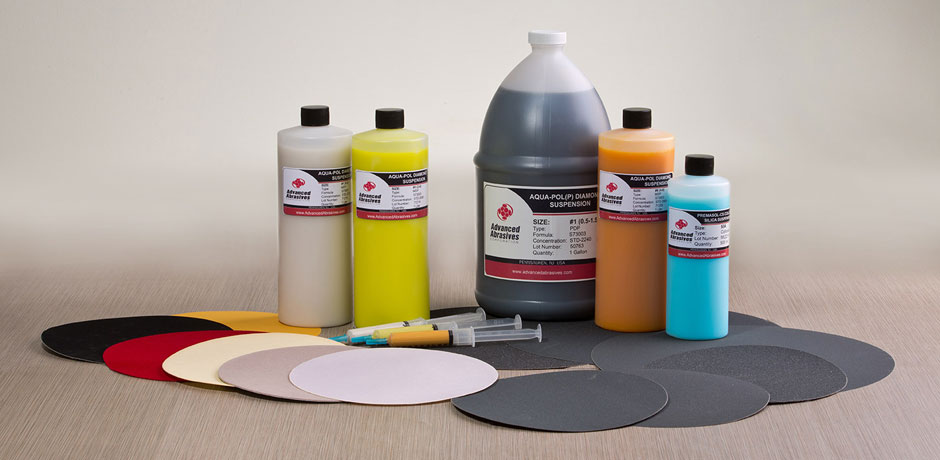
Metallographic Preparation
Achieving properly polished metallographic specimens free of polishing artifacts requires consistent quality grinding and polishing consumables.
Advanced Abrasives provides such consumables at very competitive pricing, with a selection of silicon carbide grinding papers for coarse and fine grinding, polishing cloths, diamond pastes and suspensions for coarse and fine polishing, plus a selection of mounting waxes and oxide powders and suspensions for finish polishing.
Maximize Your Metallographic Workflow with Our Silicon Carbide Grinding Papers
Proper preparation of metallographic specimens is a crucial and indispensable step in accurately determining the microstructure of a material. This process typically involves sectioning, mounting, coarse grinding, fine grinding, polishing, etching, and meticulous microscopic examination. Advanced Abrasives offers a line of silicon carbide grinding papers that can achieve just that.
Our silicon carbide grinding papers for metallographic preparation are available in a range of grit sizes, ensuring that you can find the right abrasive for your specific application. Our papers offer top-notch performance and reliable results, from coarse grits for initial material removal to fine grits for final polishing.
What sets Advanced Abrasives Corporation apart is our commitment to quality and consistency. Our silicon carbide grinding papers have a uniform thickness and controlled porosity, ensuring that each paper performs consistently and delivers accurate results every time. Additionally, our products are designed to be clog-resistant, reducing the need for frequent paper changes and increasing overall efficiency in your lab.
Diamond Suspensions/Compounds/Extenders for Metallographic Preparation
Advanced Abrasives Corporation offers a comprehensive range of premium–quality diamond suspensions, compounds, and extenders for metallographic preparation, suitable for both rough and fine grinding applications. Our products are designed to deliver consistent, reproducible, and superior results, ensuring that materials are prepared to the highest standards for microscope analysis.
Our diamond suspensions are specially formulated to provide precise surface finishing and polishing for various metals, ceramics, and composites. They are available in different concentrations of diamond particles and varying viscosities, enabling fine-tuning of the grinding and polishing process to suit your specific requirements.
Our diamond compounds are ideal for rough grinding, stock removal, and pre-polishing of hard and difficult–to–machine materials. They reduce processing times with exceptional cutting and polishing efficiency while delivering superior surface quality.
Our diamond extenders complement our other diamond products by offering cost-effective solutions for diluting and extending the life of diamond suspensions and compounds. They provide a consistent and uniform abrasive flow, ensuring optimal results for extended periods while reducing overall processing costs.
Contact Advanced Abrasives today to learn more about our premium line of diamond suspensions/compounds/extenders and how these products support metallographic preparation needs.
Oxide Polishing for Metallographic Preparation
Advanced Abrasives Corporation proudly offers its customers the latest and most advanced oxide polishing solutions for metallographic sample preparation. When diamond polishing isn’t enough to achieve publication–quality micrographs, our oxide polishing products come into play. These tools are specially designed to produce superior surface finishes on metallographic samples while maintaining their structural integrity and minimizing deformation.
Oxide polishing is a critical step in metallographic sample preparation that involves removing surface scratches and blemishes to expose a flat surface for analysis under a microscope. By reducing surface roughness, oxide polishing makes it easier to identify microstructural features such as grain boundaries, inclusions, and porosity, which are crucial for understanding the properties and behavior of metallic materials.
Our oxide polishing powders come in various particle sizes, ranging from 0.025μm to 1.0μm, which allows users to control the surface roughness and achieve the desired surface finish. Our oxide polishing powders and suspensions include high–purity–de-agglomerated alumina powder and high-purity de-agglomerated alumina suspensions to collodia silica suspension, on the other end of the spectrum.
Polishing Cloths and Pads for Metallographic Preparation
Advanced Abrasives’ self–adhesive (PSA) polishing cloths/pads and plain–backed polishing cloths are manufactured with high–quality materials such as wool fabric, woven silk cloth, synthetic cloth, and more. These materials are carefully selected to ensure that our products provide consistent and repeatable results for those requiring metallographic preparation products. Both our self–adhesive polishing cloths/pads and plain–backed polishing cloths come in 8″, 10″, and 12″ versions and are perfect for intermediate polishing, finish polishing, and a wide variety of metals.
Our polishing cloths and pads have excellent durability and longevity. They are designed to withstand the rigorous demands of metallographic preparation and can be reused many times. Learn more about our polishing cloths and pads for metallographic preparation by reaching out to Advanced Abrasives.
Important Parameters to Keep in Mind During the Abrasive Grinding Process
Maximizing the effectiveness of your metallographic abrasive tools requires attention to several key factors. These considerations help achieve high-quality sample preparation results. Advanced Abrasives products are designed to deliver superior performance, but their optimal use hinges on proper application techniques and understanding the nuances of the grinding process.
Grinding Pressure
The pressure applied during grinding significantly affects the quality of the finished sample. Too much pressure can cause excessive wear on the abrasive material and lead to undesirable artifacts on the surface of the sample. Conversely, too little pressure may result in inefficient material removal and an uneven surface. It’s essential to find the right balance — typically, moderate and consistent pressure works best. Consistency in pressure ensures uniform material removal, extending the life of your grinding papers while maintaining sample integrity.
Relative Velocity
Relative velocity between the sample and the grinding paper is another critical parameter. The speed at which the sample moves across the abrasive surface impacts the material removal rate and the surface finish quality. Higher speeds can expedite the grinding process but may introduce surface damage if not controlled properly. Lower speeds, while slower, allow for greater control and precision. Adjusting the relative velocity to match your specific requirements will help achieve the desired balance of efficiency and quality.
Direction of the Grinding/Polishing
The direction in which grinding or polishing occurs can also affect the final outcome. Cross-grinding — alternating the direction between steps — helps minimize surface scratches and ensures a more even finish. This technique reduces the likelihood of directional artifacts, resulting in a smoother, more accurate representation of the sample’s microstructure.
Grinding Paper Surface Backing
The backing material of grinding papers plays a pivotal role in their performance and durability. At Advanced Abrasives, our grinding papers feature robust backing materials designed to withstand rigorous metallographic preparation processes. The backing must offer enough flexibility to conform to the sample’s contours while remaining strong enough to resist tearing and deformation during use. High-quality backing ensures that the abrasive grains remain evenly distributed across the surface, providing consistent results and extending the paper’s lifespan.
How Important Is Metallographic Grinding During the Sample Preparation Process
Metallographic grinding is a foundational step in sample preparation, serving as the gateway to revealing the true microstructure of a material. Proper grinding removes surface deformations and irregularities introduced during sectioning, creating a flat, smooth surface suitable for subsequent polishing and analysis. Insufficient grinding can obscure important features and create misleading artifacts, compromising the accuracy of your examination. By investing in high-quality abrasives and adhering to best practices, you lay the groundwork for precise and meaningful metallographic analysis, ensuring that the samples you prepare reflect the true characteristics of the material under study.
Simplify Your Metallographic Processes Today With Advanced Abrasives
Enhance your sample preparation with Advanced Abrasives’ premium grinding solutions. Our meticulously engineered products simplify your metallographic processes, delivering consistent, high-quality results you can trust.
